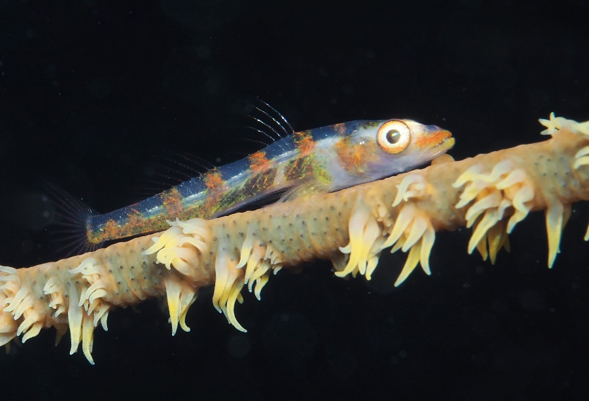Summer has proven to be an exciting time for observing new fish species in the Lord Howe Island Marine Park (LHIMP). Three species not previously recorded in the marine park have recently been reported: a potbelly seahorse (Hippocampus abdominalis), seawhip goby (Bryaninops yongei) and lattice butterflyfish (Chaetodon rafflesii).
Potbelly seahorse
Thanks to the keen eyes of resident Vivienne Crombie, a pot belly seahorse (Hippocampus abdominalis) was recently found in the LHIMP for the first time. Seahorses are occasionally seen in the marine park, but the Australian Museum confirmed that this species is only known from New Zealand and southern mainland Australia. It is the largest species of seahorse in Australia, growing up to 35cm and is known to attach itself to drifting seaweed and raft in open water. This small individual was found washed up dead amongst dried seaweed on Lagoon beach, so it is possible that it lived and died elsewhere before drifting into the marine park on ocean currents. Thanks to Viv and Audrey Ball for reporting the find!
Whip goby

Seawhip goby in the Lord Howe Island Marine Park.
Photo: Dr Chris Preston
Another new record for the LHIMP was the seawhip goby Bryaninops yongei photographed by regular visitor Dr Chris Preston.
This small fish lives exclusively on the seawhip Cirripathes anguina – a black coral with a single whip-like branch. The goby only grows to a few centimetres and is semi-transparent, so is well camouflaged on its coral host and easy to overlook. It is known from northern Australia and the Coral Sea but has not previously been recorded in the LHIMP. Dr Chris provided the following account of her exciting find: “My husband and I have visited LHI almost every year since 2002, and have made many hundreds of dives over the years during our annual 3 to 4 weeks stay. Originally, we did a little bit of diving and a lot of walking, now we just come to dive!
The LHI Marine Park keeps us coming back. For people like us with a scientific background and interest in all types of marine life, the park offers a treasure trove of diving. We appreciate being able to experience the incredible diversity of marine life and reef structures around the Island. It is great to discover new sites and to dive favourite sites again and again. We have even been lucky enough to dive in some of the sanctuary zones when we volunteered to help with Reef Life Surveys with Graeme Edgar and Rick Stuart-Smith in previous years.
On our dives, we are always on the look-out for subjects of scientific interest and take photographs to record and identify what we see. Part of the fun of diving is finding something we have not seen before. We contact the marine park when we find something new or unusual. This year I was thrilled to photograph a tiny Sea whip goby which was a new record for the marine park.
Macro photography helps us see the little stuff that most people don’t even know is there. We are not professional photographers; we use our best pictures in our university science teacher education classes and in educational publications.
This year we made 33 dives each from mid-January to early February. Dive sites included Balls Pyramid and South-East rock, Georges Bay and Red Point to the South, Clear Place and Middle Beach to the east, Octopus Garden and Split Rock to the west, the Gutters North head and Yellow Rock to the North, the Admiralty Islands, and Erscott’s Hole in the Lagoon looking for (but not finding) the elusive Coleman’s Pigmy Seahorse. Our mantra – take only photos and leave only bubbles – helps preserve the marine park. We can’t wait to dive LHI again!”
Lattice butterflyfish
Following recent observations of a bentstick pipefish, goldstripe butterflyfish and great seahorse in Sylphs Hole, the unique habitat and protected waters in this part of the Lord Howe Island lagoon have attracted another unusual visitor.

Lattice butterflyfish in the Lord Howe Island Marine Park. Photo: Kim Pryor
A lattice butterflyfish (Chaetodon rafflesia) was photographed for the first time in the LHIMP at Sylphs Hole by return visitor Kim Pryor. This species is known to live in pairs on sheltered coastal reefs around northern Australia and elsewhere in the tropics. Kim also provided an account of her observation: “My husband and I have holidayed at stunning Lord Howe Island for the last 4 years. On Saturday, 20 January 2024, we snorkelled at Old Settlement Beach. I always notice butterflyfish, angelfish, anemonefish, wrasse and parrotfish first when I’m diving or snorkelling.
“On this snorkel, I saw a Goldstripe butterflyfish Chaetodon aureofasciatus then noticed a Lattice butterflyfish Chaetodon rafflesii. The Lattice butterflyfish was unmistakable: it shone brilliant yellow against the brown corals. I was very excited because I knew I hadn’t seen either species at Lord Howe Island.
When I confirmed the ID and looked up the distribution records on iNaturalist, I was thrilled to discover that the Goldstripe butterflyfish had first been recorded at Lord Howe Island only three months earlier and the Lattice butterflyfish was a new species distribution record! Furthermore, 2 years ago, I got another new species distribution record, the Banded snake eel Myrichthys colubrinus at Ned’s Beach!”
Thanks to everyone who records and reports their unusual observations in the LHIMP. These and other new records will be added to future updates of Checklist of the coastal fishes of Lord Howe, Norfolk and Kermadec Islands, southwest Pacific Ocean. The current version of the checklist is available free via: https://doi.org/10.6084/m9.figshare.21563766.v1.


